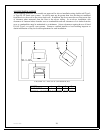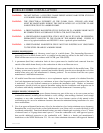
Version 2.0b 29
FIGURE 12 demonstrates a direct connect (simplest) vent system attached to a Country Flame
Harvester. There are a number of critical factors that need to be considered when using the direct
connect method. What is the clearance from the ground to the jet cap? What amount of snow (or drift)
can be expected (anything blocking the exhaust will inhibit proper Harvester combustion?) What is the
exterior covering on the house (combustible or non-combustible?) What are the prevailing wind
directions (strong winds blowing directly into the exhaust pipe will cause combustion problems?) What
is the ground covering around the jet cap (dry grass can be ignited from sparks causing a house fire?)
Despite the direct connect low initial cost, improper planning can lead to expensive problems. Consult
with a professional.
FIGURE 13: FLEXIBLE LINER VENT SYSTEM INSTALLATION
FIGURE 13 demonstrates a freestanding connection to an existing masonry fireplace chimney. The
freestanding connection will require the use of at least one clean out tee located at the back of the
Harvester. The diameter of the clean out tee pipe and other vent pipe will be determined by the length
of overall pipe required in a specific application. In many cases an additional clean out tee will be
required inside the chimney. Failure to provide clean out access to this kind of installation will require
additional services of a certified chimney sweep. Chimney sweeps maintain the equipment necessary to
professional clean a Harvester installation that does not provide clean out tees. A certified installer will
take all site specific requirements into account when completing an installation for the homeowner.


















